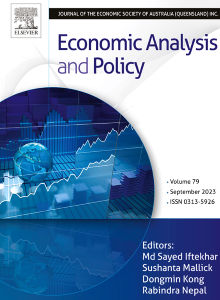Can money help to achieve the Paris agreement goal? the missing piece of the puzzle: How green monetary policy can bridge the emissions gap
IF 7.9
2区 经济学
Q1 ECONOMICS
引用次数: 0
Abstract
Despite the global commitment to reducing emissions outlined in the 13th Climate Action Plan and the Paris Agreement (aiming for a 43 % reduction by 2030 and net zero by 2050), current efforts appear insufficient. While green technologies and sustainable practices are gaining traction, research on aligning monetary policy with environmental goals remains scarce. This study addresses this gap by exploring a framework of Green Monetary Policy (GMP) effectiveness in limiting emissions in G20 economies, using data from 2012–2022. The study adopts a modified New Keynesian Model (NKM) with CO2 emissions per capita as the dependent variable and six independent variables: GDP per capita (GDPPC), energy consumption per capita (ENCPC), energy prices (ENP), real interest rates (MP), broad money (M3), and green finance (GF). We apply Fully Modified and Dynamic OLS as long-run estimators and Quantile Regression for robustness. Additionally, Structural Equation Modeling assesses mediation, while Financial Structure and Promotion Theories guide a comparative analysis incorporating financial development and consumer price indices. Our findings reveal that GMP significantly reduces emissions, with MP, M3, GF, ENP, and CPI showing a negative impact. Conversely, GDPPC, ENCPC, and FDTI were positively associated with emissions. However, the effect of GDPPC on emissions can be mitigated through the mediating role of human capital. GDPPC and FDTI restrict the contribution of Environmental Regulations (ER) to reduce emissions. Moderation analysis indicates that ERMP increases emissions, while other interactions show no significant impact. This study also provided the theoretical base of the monetary resilience approach (MRA) to understand the monetary-energy-emission nexus (MEE nexus) to limit emissions by indicating the nonsystematic green money supply cycle. The study offers policy recommendations to central bankers and policymakers to play their role via the GMP framework for achieving the 13th Climate Action Plan in pursuance of Paris Agreement goals without compromising economic growth and environmental quality.

求助全文
约1分钟内获得全文
求助全文
来源期刊

Economic Analysis and Policy
ECONOMICS-
CiteScore
9.80
自引率
9.20%
发文量
231
审稿时长
93 days
期刊介绍:
Economic Analysis and Policy (established 1970) publishes articles from all branches of economics with a particular focus on research, theoretical and applied, which has strong policy relevance. The journal also publishes survey articles and empirical replications on key policy issues. Authors are expected to highlight the main insights in a non-technical introduction and in the conclusion.
 求助内容:
求助内容: 应助结果提醒方式:
应助结果提醒方式:


